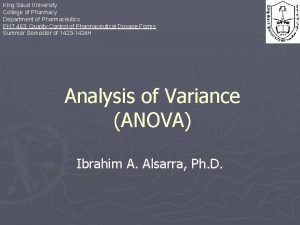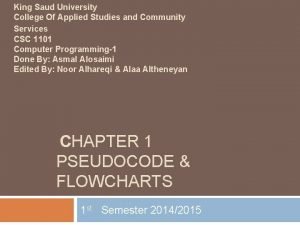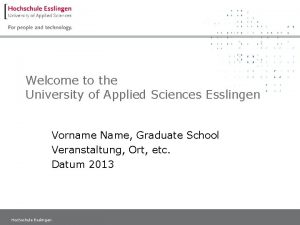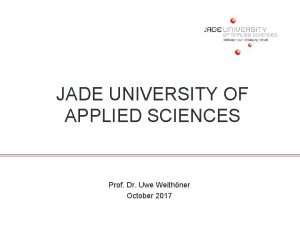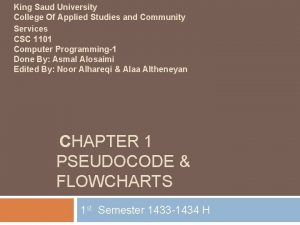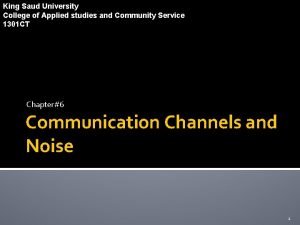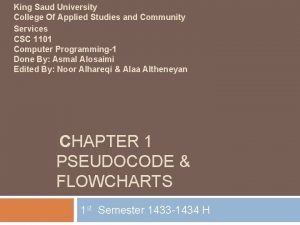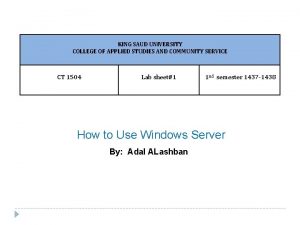King Saud University College of Applied studies and


























- Slides: 26

King Saud University College of Applied studies and Community Service By: Nour Alhariqi Edited: Elham Sunbu Introduction 1 st semester 1439 - 1440 1

Outline • Communication system model • Mode of Communication • Data Transmission Mode • Analog and digital communication system • Effectiveness of Communications System 2

Communications System • Communication is the sharing of information. Local , Over distance. • A Communication System is a combination of processes and the hardware used to accomplish the transfer of the Information. 3

Communications System Model 4

Communications System Model • Transmitter: process the message signal into a form suitable for transmission over the communication channel. • Communication channel: provide a pathway between the transmitter's output and the receiver's input. • Receiver: process the received signal to recover the appropriate message signal. 5

Mode of Communication • There are two basic mode of communication: 1 - Broadcasting single transmitter and numerous receiver. 2 - Point to point communication single transmitter and single receiver. Broadcasting Point to point 6

Data Transmission Mode • Data transmission between two devices can be: 7

Analog and Digital Data Analog Digital 8

Analog and Digital Data • Analog Data data takes on continues values. E. g. , human voice, weight, temperature values. • Digital Data data takes on discrete values. E. g. , text data 9

Analog and Digital Signals • There are two methods in transmitting a message signal over the communication channel: analog or digital 10

Analog and Digital Signals • Analog signal: is a signal whose amplitude can take on any value in a continues range. • Digital signal: is a signal whose amplitude can take on only a finite number of values. 11

Data and Signals 12

Data and Signals 13

Analog Communication System • Analog Communication is a communication method of conveying voice, data, image, signal or video information using a continuous signal. • Which varies in amplitude, phase, or some other property in proportion to that of a variable. 14

Analog Communication System 15

Analog Communication System • The transmitter block contains the modulator device. • The receiver block contains the demodulator device. • The modulator modulates a carrier wave (the electromagnetic wave) which has a frequency that is selected from an appropriate band in the radio spectrum. 16

Digital Communication System • Digital communication is a mode of communication where the information is encoded digitally as discreet signals and electronically transferred to the recipients. 17

Digital Communication System 18

Digital Communication System • Source Encoder: compresses the data into minimum number of bits. This process helps in effective utilization of the bandwidth. • Channel Encoder: The channel encoder, does the coding for error correction. • Digital Modulator: The signal to be transmitted is modulated here by a carrier. 19

Digital Communication System • Channel Decoder: The channel decoder does some error corrections. • Source Decoder: The source decoder recreates the source output. 20

21

Effectiveness of Communications System • The effectiveness of a communications system depends on four fundamental characteristics: Delivery Accuracy Timeliness Jitter 22

Effectiveness of Communications System • Delivery: The system must deliver information to the correct receiver. Information must be received by the intended device or user and only by that device or user. • Accuracy: The system must deliver the information accurately. Information that have been altered in transmission and left uncorrected are unusable. 23

Effectiveness of Data Communications System • Timeliness: The system must deliver information in a timely manner. Information delivered late are useless. In the case of video and audio, timely delivery means : delivering data in the same order as they are produced, and without significant delay. This kind of delivery is called real-time transmission. 24

Effectiveness of Data Communications System • Jitter: Jitter refers to the variation in the packet arrival time. It is the uneven delay in the delivery of audio or video packets. For example, let us assume that video packets are sent every 3 ms. If some of the packets arrive with 3 ms delay and others with 4 ms delay, an uneven quality in the video is the result. 25

Any Question? 26
 King saud university college of medicine
King saud university college of medicine King saud university college of medicine
King saud university college of medicine Prodofol
Prodofol King saud university college of pharmacy
King saud university college of pharmacy King saud university college of medicine
King saud university college of medicine King saud university college of pharmacy
King saud university college of pharmacy King saud university college of pharmacy
King saud university college of pharmacy King saud university college of business administration
King saud university college of business administration King saud university mechanical engineering
King saud university mechanical engineering King saud university riyadh
King saud university riyadh King saud university hospital nurse salary
King saud university hospital nurse salary Oscillopsia
Oscillopsia College of engineering, king abdulaziz university
College of engineering, king abdulaziz university 沈榮麟
沈榮麟 Uc ceas
Uc ceas Paradigm shift from women studies to gender studies
Paradigm shift from women studies to gender studies Van hall larenstein, university of applied sciences
Van hall larenstein, university of applied sciences Vaasa university of applied sciences
Vaasa university of applied sciences Oulu university of applied sciences
Oulu university of applied sciences Fh triesdorf agrartechnik
Fh triesdorf agrartechnik Kodolanyi janos university budapest campus
Kodolanyi janos university budapest campus Western norway university of applied sciences
Western norway university of applied sciences Automotive engineering esslingen
Automotive engineering esslingen Piraeus university of applied sciences
Piraeus university of applied sciences Jade university of applied sciences
Jade university of applied sciences Iuas
Iuas Eberswalde university of applied sciences
Eberswalde university of applied sciences



